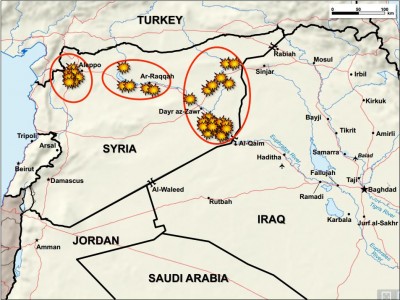Syria-Iraq Battlespace, International Military Review

The Syrian Arab Army (SAA) in coordination with the National Defense Forces (NDF) and the Palestinian militia “Liwaa Al-Quds” smashed the ISIS militants at the western outskirts of Ithriyah. This provides a ground to reopen the road between Ithriyah and Salamiyah inside the Hama province.
Nonetheless this success looks badly amid the ISIS counter actions in another sector. Militants cut off route along the Aleppo-Khanasser highway that leads to the Aleppo province. As long as ISIS has control of the road, the Syiran government’s supplies aren’t possible through it.
Since Saturday morning, the SAA and its allies have continued their operations in Jabal Al-Akrad, targeting Al-Nusra’s defensive positions at the northern axis of Kataf Al-Ghaddar. In addition to the capture of Kataf Al-Ghaddar, the Syrian Arab Army’s Special Forces have advanced inside the strategic city of Salma, capturing several building blocks and hilltops from the terrorists.
The area around Salma has become on the Russian Air Force’s primary targets due to its proximity to the terrorist stronghold of Jisr Al-Shughour. Separately, the Russian Air Force has continued to bomb ISIS targets in the Al-Raqqa province.
Another top commander of Iran’s Islamic Revolution Guards Corps (IRGC), Brigadier General Reza Khavari, was killed in clashes in the Northern parts of the province of Hama on October 22. SouthFront: Analysis & Intelligence remembers 7 other IRGC members, mostly from Ansar Corps, have been martyred in Syria in the last days according to the confirmed reports.
Russia has been continuing diplomatic efforts to set a wide coalition aimed to conduct anti-terror operations in Syria and Iraq instead of trying to overthrow Assad by supporting militant powers in the region. On October 23, Russia and Jordan made an agreement to set a coordination center in Amman. The center will be used to share information on the counter-terrorism operations. Russia, Iran, Iraq and Syria already have a Baghdad-based center used for the same goal.
This activity is hardly facing a joint counter-strategy from the US-led powers and regional elites. On the one hand, Western media, think tanks and experts argue that Russia doesn’t fight ISIS. On the other hand, same think tanks and experts believe that without the direct Russian military involvement, the Islamic State had all chances to break the back of the Syrian forces by the end of 2015.
In this case, ISIS had to launch attacks west of Palmyra against the T4 Airbase, Homs city and Qusayr while Al Nusra and other so-called “moderate rebels” were advancing in northern Latakia, Aleppo city, and northern Damascus. Then ISIS had to exercise a death blow to the dispersed government forces by attacking south of Homs.
Thus, the establishment of a Russian airbase in Latakia in September 2015 smashed these plans by preventing both “moderate terrorists” and ISIS from advancing along Syria’s central corridor. Nonetheless, it seems that a part of Western elites aren’t happy by this result. They prefer to see Syria divided among ISIS militants, Al Nusra and other terrorist groups.
Nonetheless, the Pentagon has offered a new strategy to regain the initiative in the Middle East. As SouthFront: Analysis & Intelligence forecasted, the strategy will include coordinated offensives involving Syrian and Iraqi Kurdish forces, the Iraqi army and Iranian-backed Shia militias supported by the US Air Force. Ash Carter, the US defense secretary, and senior officials are expected to outline the strategy to Congress next week.
We remember, Iraqi forces retook the town of Baiji in the Salaheddin province on Tuesday. Baiji is located about 180 kilometers south of the major city of Mosul, which fell to the ISIS militants in June 2014. The town, which is home to Iraq’s largest oil refinery, has been the scene of fierce clashes between terrorists and pro-government forces over the past weeks. Upcoming US-led military efforts will be likely focused there.

